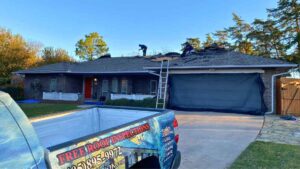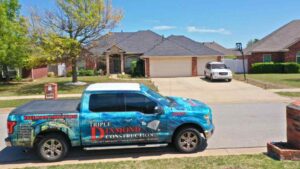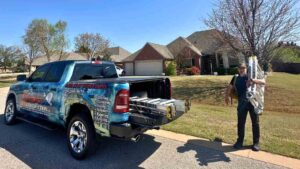Follow our essential tips to maximize your home’s energy efficiency this fall!
As summer’s warmth begins to fade and the cool breeze of autumn starts to roll in, homeowners in Oklahoma City are reminded that it’s time to prepare for the colder months ahead. The transition between seasons is the perfect opportunity to take a closer look at your home’s energy efficiency.
Making small adjustments now can lead to significant savings on your energy bills and ensure your home stays comfortable throughout the winter. Not sure how to get started? Keep reading to learn our expert tips to boost your home’s energy efficiency as temperatures begin to drop.
1. Improve Insulation for Better Temperature Control
Insulation is one of the most critical factors in maintaining a comfortable and energy-efficient home. Proper insulation helps to keep warm air inside during the winter and cool air inside during the summer, reducing the strain on your heating and cooling systems and lowering your energy bills.
Key Areas to Insulate:
- Attic: Heat rises, so an inadequately insulated attic can result in significant heat loss. Adding or upgrading attic insulation is one of the most effective ways to improve energy efficiency. Materials like fiberglass, cellulose, or spray foam insulation are commonly used to enhance attic insulation.
- Walls: If your home’s walls are poorly insulated, they can allow heat to escape during the winter. Consider adding insulation to exterior walls or checking for gaps where insulation may be missing. You may also want to upgrade your home’s siding!
- Floors and Basements: Cold floors in winter can be a sign of poor insulation. Insulating the floors above unheated spaces like basements or crawl spaces can help maintain a more consistent indoor temperature.
Insulation Upgrades:
- Blown-in Insulation: This type of insulation can be added to existing walls or attics without major renovations, making it an excellent option for older homes.
- Spray Foam Insulation: Provides excellent coverage and fills in gaps and cracks where air may be leaking, offering both insulation and an air barrier.
2. Seal Windows and Doors to Prevent Drafts
Old windows and doors are common sources of drafts, which can significantly reduce a home’s energy efficiency. Even small gaps or cracks around windows and doors can allow warm air to escape, leading to increased energy usage and higher utility bills.
Tips for Sealing Windows and Doors:
- Weatherstripping: Apply weatherstripping around doors and windows to seal gaps. This is an affordable and effective way to prevent drafts and improve insulation.
- Caulking: Use caulk to seal cracks around window frames and door casings. Over time, caulk can wear out, so it’s essential to inspect and reapply it as needed.
- Install Storm Windows: Adding storm windows can create an additional barrier against the cold, reducing heat loss through windows.
- Use Window Insulation Film: This clear plastic film can be applied to windows to create an insulating layer, reducing drafts and heat loss during the winter months.
3. Maintain Your HVAC System for Optimal Performance
Your HVAC (Heating, Ventilation, and Air Conditioning) system plays a vital role in maintaining a comfortable indoor environment as temperatures fluctuate. Regular maintenance ensures that your system operates efficiently, reducing energy consumption and extending its lifespan.
HVAC Maintenance Tips:
- Replace Air Filters: Dirty air filters reduce airflow and force your HVAC system to work harder. Replace filters every one to three months, or as recommended by the manufacturer.
- Schedule a Professional Tune-Up: Have a qualified technician inspect and service your HVAC system before the heating season begins. This tune-up should include checking the thermostat, inspecting ductwork, and cleaning components like the blower and heat exchanger.
- Upgrade to a Programmable Thermostat: A programmable thermostat allows you to set different temperatures for various times of the day, reducing energy usage when you’re not at home or during the night.
- Seal Ductwork: Leaky ducts can cause your HVAC system to lose up to 30% of its efficiency. Sealing ducts with mastic or metal-backed tape can improve your system’s performance and reduce energy waste.
4. Upgrade to Energy-Efficient Windows
If your windows are old or single-paned, they may be contributing to heat loss in the winter. Upgrading to energy-efficient windows can make a significant difference in your home’s overall energy efficiency. According to EnergyStar, upgrading your home’s windows can cut your heating and cooling costs by at least 20% – making it one of the best energy-efficient upgrades you can invest in!
Benefits of Energy-Efficient Windows:
- Improved Insulation: Energy-efficient windows typically feature double or triple panes of glass with insulating gas, such as argon, between the panes. This design helps to keep warm air inside during the winter and cool air inside during the summer.
- Low-E Coatings: Low-emissivity (Low-E) coatings on windows reduce heat transfer, improving insulation and helping to block harmful UV rays that can fade furniture and flooring.
- Reduced Condensation: Energy-efficient windows are less likely to accumulate condensation, which can lead to mold and mildew growth.
Not sure if your home needs new windows? Use our free online guide for warning signs that windows should be replaced and calculate your energy savings!
5. Utilize Natural Sunlight for Passive Heating
Maximizing natural sunlight is a simple yet effective way to reduce heating costs during the colder months. By allowing more sunlight into your home, you can take advantage of passive solar heating, which helps to warm your home naturally.
How to Maximize Sunlight:
- Open Curtains and Blinds: During the day, open curtains and blinds on south-facing windows to let in as much sunlight as possible. Sunlight can significantly warm up your home, reducing the need for additional heating.
- Use Insulated Curtains at Night: Close curtains and blinds at night to retain the heat gained during the day and prevent drafts.
6. Consider a Home Energy Audit
If you’re serious about improving your home’s energy efficiency, consider scheduling a home energy audit. A professional energy auditor can assess your home’s energy usage and identify areas where improvements can be made. The audit may include testing for air leaks, inspecting insulation levels, and evaluating the efficiency of your HVAC system.
Benefits of a Home Energy Audit:
- Identify Hidden Issues: An energy audit can uncover areas of your home that are wasting energy, such as hidden drafts, inadequate insulation, or inefficient appliances.
- Customized Recommendations: Based on the audit’s findings, you’ll receive personalized recommendations for upgrades that can have the most significant impact on your home’s energy efficiency.
- Potential Cost Savings: Implementing the recommended improvements can lead to substantial savings on your energy bills over time.
Key Energy Efficiency Takeaways
As the seasons change, taking steps to improve your home’s energy efficiency can make a noticeable difference in both comfort and cost savings. By upgrading insulation, sealing windows and doors, maintaining your HVAC system, and considering energy-efficient upgrades, you can create a more energy-efficient home that’s ready for the colder months ahead.
At Triple Diamond Construction, we’re here to help you with all your home improvement needs. Whether you’re looking to improve insulation, upgrade your windows, or ensure your roofing system is in top shape, our team of professionals is ready to assist you. Contact us today to learn more about how we can help you create a more energy-efficient home this season!





